WILLIAM E. JONES
03 September - 31 October 2009
Curated by Luigi Fassi
The cultural history of sexuality, ideologies of power and strategies of social control are the main themes of the first single show by the American artist William E. Jones in Europe (born 1962, Canton, Ohio, USA, lives and works in Los Angeles).
The work of William E. Jones unfolds along the social history of the Twentieth Century, investigating events that have fallen into oblivion through the use of visual materials and archival research. Pornographic films of the Sixties, footage of judicial investigations and undeveloped photographic negatives all become the raw material through which the artist undertakes an operation of interpretative excavation, to the point of activating a surprising semantic renewal of various cultural documents which are not usually considered relevant.
Tearoom (1962/2007), the main work of the exhibition, consists of footage shot in the summer of 1962 by the police departement of Mansfield, Ohio with the aid of hidden video cameras. The resulting film, technically an objet trouvé presented in its entirety by the artist, shows the frenetic exchange of homosexual intercourse in public restrooms, located on a main square of this city in the American midwest. As a pioneering experiment in social control by means of the usage of technology, Tearoom describes the strategies of the criminalization of homosexuality in the America of the Sixties, as a reflection on the repressive exercise of authority and at the same time a fascinated and nostalgic portrait of homoerotic sexuality prior to the emergence of AIDS. Created with the precise intentions of investigative documentation, almost fifty years after its production Tearoom is still a cultural object which is difficult to fully grasp, a work full of mystery within the almost inexhaustible stratification of its signifiers.
Other works in the show, such as Killed (2009) and the photographic series Sailors, Pan, Orpheus (Francis Benjamin Johnston and F. Holland Day) (2008), both assembled from images derived from the archive of the Library of Congress in Washington, D.C. also bear witness to the unwavering interest of the artist in working with archival materials, which are treated here as a powerful philosophical catalyst for the rediscovery of hidden narratives, ideological manipulations, events and their possible interpretations.
The work of William E. Jones is thus a journey through the labyrinthine dimensions of contemporary history, the outcome of an impure and penetrating gaze capable of challenging the most consolidated and traditional images of modernity.
Text Luigi Fassi




